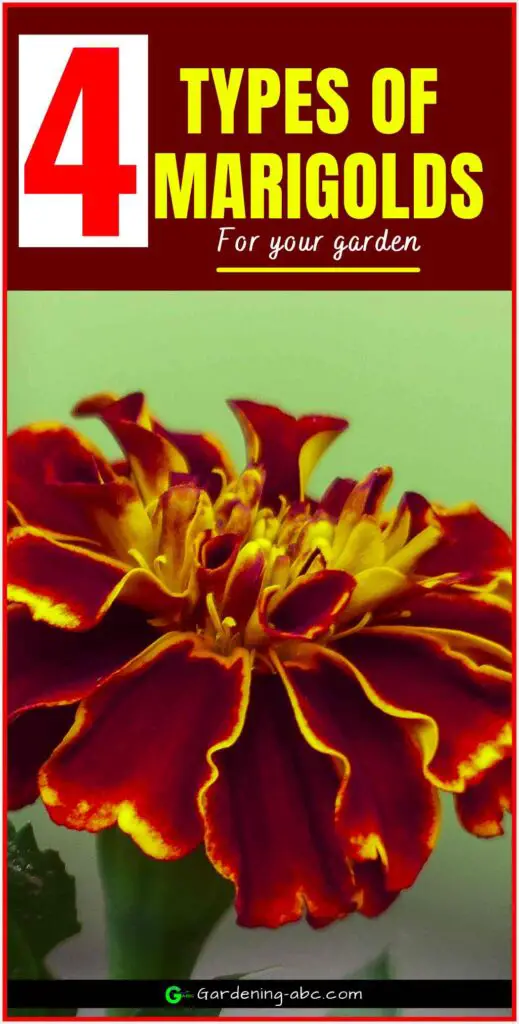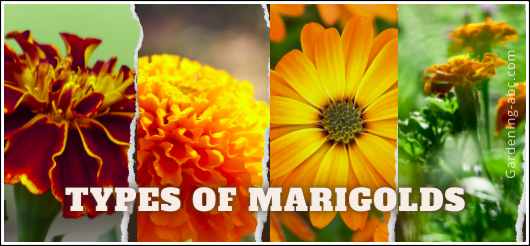We use affiliate links to run our site. When you buy through links on our site, we may earn an affiliate commission, without any added cost to you. Learn more
Marigold is a very popular flowering plant, especially during the summer. There are many varieties that vary widely in color and size, with some blooming at a single stage while others are ready to bloom in waves throughout the season.
If you are looking to plant marigolds in your garden or flowerbed, you are probably trying to decide between the different types of marigolds that exist.
In fact, there is more than one type of marigold and they have different colors and leaf sizes.
So, today, we’ll be discussing the different types of marigolds and which one suits you the best.
Different Types of Marigold Plants:
Different types of marigolds are available for planting in the garden. The 4 most common types include
- African Marigolds or Aztec Marigolds,
- French Marigolds,
- Signet Marigolds,
- Triploid Marigolds
Let’s look more into these types:
African Marigold or Aztec Marigold (Tagetes erecta):
African or Aztec Marigolds (Tagetes erecta) are native to Mexico and Central America. They are a beautiful addition to any garden because they are very easy to grow and come in a variety of colors.
These types of marigolds have very large flowers and they are ideal for making floral arrangements, decorations, and even bouquets.
African marigolds grow best in full sun and are also a little more tolerant of dry weather than French marigolds.
African marigolds can grow up to 3 ft so you can use them to create backgrounds. they also make excellent bedding plants.
These marigold plants can produce large-size flowers. it can grow up to five inches wide.
French Marigold (Tagetes patula):
The French marigold is another popular variety that produces large, brightly colored blooms that attract butterflies and bees.
French marigolds are available in a variety of colors, including pale yellow, orange, and red.
French Marigolds are quite sturdy and can grow up to 18 inches making them ideal for growing in containers.
They will bloom all summer long if you deadhead them regularly by cutting off spent flowers at their base so new ones can form on the stem above it.
French marigolds grow best in full sun to partial shade and you should plant them 6-8 inches apart from each other to allow for good air circulation around the plant.
They require little care once established in your garden. Unlike other types of marigolds, french marigolds can hold up better in rainy weather.
Besides making an attractive addition to any flower garden because of its long blooming season from spring through fall, French marigolds are also used in making perfumes and exquisite foods.
Signet Marigold (Tagetes signata):
They are delicate, and lacy, and can grow up to 14 inches tall with dark green lemon-scented foliage.
Signet marigold plants produce small yellow flowers in full sun conditions throughout the summer months.
They grow up to 14 inches tall with dark green foliage.
You can even eat signet marigolds they have a spicy tarragon flavor. You can grow them both in your regular and your herb garden.
Overall they are low-maintenance flowers.
Triploid Hybrids:
These marigolds are a cross between American and French marigolds.
Triploid marigolds can have extremely large flowers that are strong and sturdy, even in challenging environments. They produce flowers that last longer than other types.
Unlike other types of marigolds, these ones can be a bit challenging to grow.
What about Potted Marigolds?
Potted marigolds are one of the most popular flowers that you can grow in your house. But they are not marigolds.
The botanical name of potted marigolds is Calendula officinalis. Here are the major differences between a potted marigold and a true marigold plant.
conclusion:
If you are thinking of planting marigolds in your garden, now you know that there are many varieties to choose from, so choose wisely.
I can’t tell you which one to pick because each variety has its own charm. It all boils down to what your preference is.
Know how to grow marigolds and use them as ornamental plants in your flower beds. They will give a colorful touch to your garden beds, and the best thing about them is that they don’t require much maintenance at all.
I hope this post has been helpful to you. You can read more about marigold gardening here.
If you like the information, share it with others, and Don’t Forget to PIN IT.

Amazon and the Amazon logo are trademarks of Amazon.com, Inc, or its affiliates.

Hi there! My name is Prasenjit and I’m an avid gardener and someone who has grown a passion for growing plants. From my hands-on experience, I have learned what works and what doesn’t. Here I share everything I have learned.
